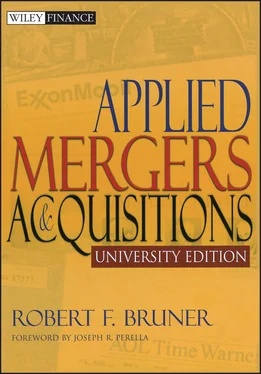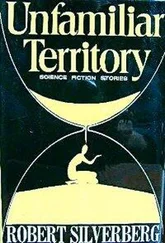M&A to build market power does not pay. Studies by Ravenscraft and Scherer (1987), Mueller (1985), and Eckbo (1992) reveal that efforts to enhance market position through M&A yield no better performance, and sometimes worse. Studies by Stillman (1983) and Eckbo (1983) find that share price movements of competitive rivals of the buyer do not conform to increases in market power by buyers. The studies suggest that the sources of gains from M&A do not derive from anticompetitive combination of firms.
Paying with stock is costly; paying with cash is neutral. Chapter 20reviews the research on how form of payment is associated with returns to investors. Asquith, Bruner, and Mullins (1987), Huang and Walkling (1987), Travlos (1987), Yook (2000), and Heron and Lie (2002) found that stock-based deals are associated with negative returns to the buyer’s shareholders at deal announcements, whereas cash deals are zero or slightly positive. This finding is consistent with theories that managers time the issuance of shares of stock to occur at the high point in the cycle of the company’s fortunes, or in the stock market cycle. Thus, the announcement of the payment with shares (like an announcement of an offering of seasoned stock) could be taken as a signal that managers believe the firm’s shares are overpriced.
Returns vary over time. The studies show a slight tendency for bidder returns to decline over time: Returns appear to be higher (more positive) in the 1960s and 1970s than in the 1980s and 1990s, except for deals in technology and banking, where returns to bidders increase in the 1990s. 10 Moeller et al. (2003) reported a dramatic decline in bidders’ returns from 1997 to 2001. Fan and Goyal (2002) found that the average return to bidders and targets combined rises from 1962 to 1996.
M&A regulation is costly to investors. Wier (1983) and Eckbo (1983) found evidence suggesting that Federal Trade Commission antitrust actions benefit competitive rivals of the buyer and target. Jarrell and Bradley (1980) and Asquith, Bruner, and Mullins (1983) found that returns to merging firms were significantly higher before than after implementation of the Williams Act of 1968. Schipper and Thompson (1983) considered four regulatory changes between 1968 and 1970, and found wealth-reducing effects associated with increased regulation.
Rule of laws and property rights matter in cross-border deals. Chapters 5and 12discuss the impact of country risks on the success of cross-border mergers. Kuipers et al. (2003) found that “foreign acquirers earn significantly higher returns when the rule of law is strong in their country, and their associated U.S. targets earn significantly lower acquisition premiums.” ( Page 24)
M&A to use excess cash generally destroys value except when redeployed profitably. Cash-rich firms have a choice of returning the cash to investors through dividends, or reinvesting it through such activities as M&A. Studies 11 report value destruction by the announcement of M&A transactions by firms with excess cash. However, Bruner (1988) reports that the pairing of slack-poor and slack-rich firms creates value. Before merger, buyers have more cash and lower debt ratios than nonacquirers. And the return to the buyers’ shareholders increases with the change in the buyer’s debt ratio due to the merger.
Tender offers create value for bidders. Chapters 32and 33survey the tender offer process and research on returns. Mergers are typically friendly affairs, negotiated between the top management of buyer and target firms. Tender offers are structured as take-it-or-leave-it proposals, directly to the target firm shareholders, often hostile in attitude. Some research summarized in Chapter 32suggests that targets of hostile tender offers are underperformers with relatively low share prices. Thus, the better returns from tender offers may reflect bargain prices and/or the economic benefits of replacing management and redirecting the strategy of the firm. Several studies report larger announcement returns to bidders in tender offers, as compared with friendly negotiated transactions. 12
When managers have more at stake, more value is created. Studies suggest that returns to buyer firm shareholders are associated with larger equity interests by managers and employees. 13 In assessing the pattern of performance associated with deal characteristics, Healey, Palepu, and Ruback (1997) concluded, “While takeovers were usually break-even investments, the profitability of individual transactions varied widely … the transactions characteristics that were under management control substantially influenced the ultimate payoffs from takeovers.” 14 A related finding is that leveraged buyouts (LBOs) create value for buyers. The sources of these returns are not only from tax savings due to debt and depreciation shields, but also significantly from efficiencies and greater operational improvements implemented after the LBO. In LBOs, managers tend to have a significant portion of their net worth committed to the success of the transaction. Exhibit 3.11summarizes the findings of several studies about LBOs and reveals that cash flow increases and capital spending declines materially in the years following the transaction. Chapter 13relates more research findings about LBOs and other highly levered transactions.
The initiation of M&A programs is associated with creation of value for buyers. Asquith, Bruner, and Mullins (1983), Fuller, Netter, and Stegemoller (2002), Gregory (1997), and Schipper and Thompson (1983) report that when firms announce they are undertaking a series of acquisitions in pursuit of some strategic objectives, their share prices rise significantly. That these kinds of announcements should create value suggests that M&A generally creates value, and that the announcement is taken as a serious signal of value creation.
EXHIBIT 3.11 Summary of Performance Studies for M&A: LBO Results
| Study |
Change in Operating Cash Flow/Sales |
Change in CapEx Sales |
Sample Size |
Sample Period |
Event Window (Years) |
| Kaplan (1989) |
11.9% |
–31.6% |
37 |
1980–1986 |
(–1,2) |
| Muscarella, Vetsuypens (1990) |
23.5% |
–11.4% |
35 |
1976–1987 |
Various |
| Smith (1990) |
18.0% |
–25.0% |
18 |
1976–1986 |
(–1,2) |
| Opler (1992) |
16.5% |
–42.2% |
42 |
1985–1989 |
(–1,2) |
| Andrade, Kaplan (1998) |
54.5% |
–40.7% |
124 |
1980–1989 |
(–1,1) |
FINDINGS FROM SURVEYS OF EXECUTIVES
The findings of scholars in large-sample surveys are supplemented by studies by scholars and practitioners who focus on smaller samples and typically draw some or all of their findings from questions of managers directly. Ingham, Kran, and Lovestam (1992) surveyed chief executive officers in 146 large firms in the United Kingdom. Of them, 77 percent believed that profitability increased in the short run after merger; 68 percent believed that the improved profitability lasted for the long run.
Surveys by practitioners are often rather casually reported, limiting our ability to replicate the study and understand the methodological strengths and weaknesses. For this reason, scholars tend to give practitioner surveys rather less attention. Nevertheless, a sample of these surveys is reported here for the sake of comparison with the scholarly studies. It is interesting to consider whether managers tell us something different from the large-sample scientific studies.
The absence of statistical tests in these surveys limits the assertions one can make, but a qualitative review of results offers results surprisingly similar to the scientific studies. Exhibit 3.12tabulates the results of 12 studies. Six of the 12 studies suggest negative results. The remainder seem neutral or positive. The similarity between these findings and the findings from the scholarly studies is striking. In the bulk of deals, it appears that investments in acquisitions at least pay their cost of capital.
Читать дальше












